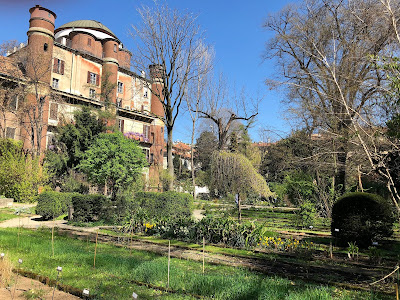Milan Cathedral
We started our exploration of Milan at the Cathedral, a truly magnificent building. You can see from the exterior that it consists of a nave with two aisles on each side. I was surprised to discover that it is the largest church in Italy (on a technicality: St Peter's is bigger but is in the Vatican city), the third largest in Europe and the fourth largest in the world. (I just had to look up the other two: they are Our Lady of Aparecida in Brazil and Seville.)
Work on the Cathedral was started in 1386, but the facade was not completed until 1812, when Napoleon was King of Italy.
The inside of the cathedral brings home its scale and the nave + two aisles plan gives rise to an astonishing number of columns, many of which have intriguing circular capitals.
At the east end there is a wonderful wall of stained glass in rectangular panels, each telling a story. the colours are extremely vibrant and the overall effect is quite magnificent.
One of the wonders of the cathedral is that you can go up onto the roof (by lift or stairs, we opted for the lift). You emerge from the lift to look through an opening at a line of pinnacles atop the side of one of the aisles.
You walk the length of the side and climb to the main roof, above the nave. The roof slopes somewhat and, as repair work is underway, it is somewhat cramped. You can see bright new stone work inserted amongst weathered stone. Enormous numbers of photos are being taken, including by me. It is a wonderful experience - unique, so far as I know.
Eventually, we drag ourselves away and descend. Turning right out of the cathedral, we enter the Galleria Vittorio Emanuele II. It was started in 1861, the year of Italian Unification, when Vittorio Emanuele II came to the throne of all Italy. It is a cross-shaped arcade, four storeys high with galss barrel vaults meeting at a glass dome.
The angles formed by the points of intersection are decorated with mosiacs representing the coats of arms of the three successive capitals of the Kingdom, Turin. Florence and Rome, plus that of Milan. I confess I don't know which one is depicted in my photo.
The Galleria is noticeably home to elite shops and I was interested to read that there was a controversy a few years ago when a McDonalds outlet failed to have its lease renewed despite being there for 20 years (it was replaced by Prada). After outrage and law suits a vast new McDonalds was opened just opposite one of the entrances to the Galleria and everyone was happy.
We now headed off to one of Milan's finest churches, Sant Ambrogio. It was first built by St Ambrose in 379–386 and rebuilt in the Romanesque style in the 13th century. At first sight, the cloister or atrium in front of the main facade seems the most unusual feature. The strangest however is the two bell towers. Two, separate, distinct religious communities (Canons and Monks) shared the basilica in a state of tension and both insisted on having a dedicated bell tower.
Inside the Basilica is quite plain, but the combination of stone and brick creates a dramatic appearance.
In front of the altar is an ancient canopy, whose name eludes me now.
Behind it is a beautiful 13th century mosaic of Christ Pantokrator. This is a post card as there was no realistic way of taking a photograph.
We now adjourned to the mighty castle of the Dukes of Milan. It was built in the 15th century by Francesco Sforza and is known as the Castello Sforzesco. It is a massive square structure in red brick with enormous towers at the corners and a really imposing main gate.
This is the main gate from the inside.
We briefly visited the castle in 2001 and we were astonished by how much it had changed.Compare the pictures of the courtyard below.
The castle now houses some museums (closed when we went) and seems to be the site of a classic Italian passegiata: there was a continuous and substantial flow of people walking from the front entrance to the rear one.
To complete what we thought were the main sights we visited Pinoteca de Brera (Brera art gallery). Founded in 1809, it has an astonishing collection of Italian painting up to about 1850. There are also many later items not on display and the idea has been mooted of creating a Brera Modern to display them.
Out of great range of wonderful paintings including masterworks by Bellini and Mantegna I will just pick two: Piero della Francesca's The Virgin with child, angels and saints (it id also known as the Pala Montefeltro - the donor, Federico Montefeltro of Urbino, is shown kneeling on the front right)
... and Rafael's The Marriage of the Virgin.
To complete our tour we took a clockwise walk around the periphery of the Brera to reach the secluded Orto Botanico di Brera, a delightful botanical garden (think of the Chelsea Physic Garden).
It is a delightful spot, although it was perhaps too early in the year to see it at its best.
Rating: 5 stars.



















No comments:
Post a Comment